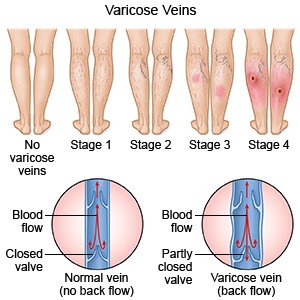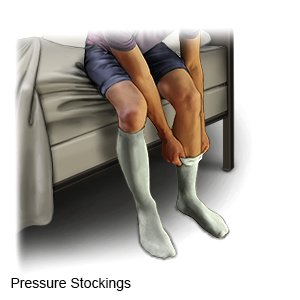Vein Stripping
Medically reviewed by Drugs.com. Last updated on Aug 4, 2025.
What do I need to know about vein stripping?
Vein stripping is surgery to remove varicose veins. Varicose veins are large, twisted veins that bulge out under your skin.
 |
How do I prepare for vein stripping?
- Your surgeon will tell you how to prepare. Your surgeon may tell you not to eat or drink anything after midnight on the day of your surgery. Arrange to have someone drive you home after surgery.
- Tell your surgeon about all your current medicines. Your surgeon will tell you if you need to stop any medicine for surgery, and when to stop. You will be told which medicines to take or not take on the day of your surgery.
- Tell a healthcare provider about all your known allergies, including to anesthesia or medicines. You may be given an antibiotic to help prevent a bacterial infection.
Related medications
What will happen during vein stripping?
- You will be given general anesthesia to keep you asleep and free from pain during surgery. Your provider will make 1 or more small incisions near the vein to be removed. You may need more incisions if other veins will be removed.
- The provider will stop the blood flow through the vein. Small tools will be used to separate the varicose vein from other blood vessels and tissues. The vein may be removed through one of the incisions.
- A drain may be inserted near your incision to remove extra blood and fluid. The incisions will be closed with stitches or sterile strips and covered with bandages.
What should I expect after vein stripping?
- Recovery takes about 3 to 6 weeks.
- You will need to wear pressure bandages or compression stockings on your legs. These usually stay on for about 3 to 4 weeks after surgery.

- You may have numbness in small areas of your legs that comes and goes. You should not have large areas of numbness or discomfort that does not go away.
What are the risks of vein stripping?
Your leg may bruise, swell, or get infected. You may also have scarring where the incisions were made. Your varicose veins may come back. You may bleed more than expected. Your nerves may be damaged, which can cause pain, numbness, or a burning feeling in your leg. You may also have trouble moving your leg or foot. You may get a blood clot in your leg. This may become life-threatening.
Care Agreement
You have the right to help plan your care. Learn about your health condition and how it may be treated. Discuss treatment options with your healthcare providers to decide what care you want to receive. You always have the right to refuse treatment. The above information is an educational aid only. It is not intended as medical advice for individual conditions or treatments. Talk to your doctor, nurse or pharmacist before following any medical regimen to see if it is safe and effective for you.© Copyright Merative 2025 Information is for End User's use only and may not be sold, redistributed or otherwise used for commercial purposes.
Further information
Always consult your healthcare provider to ensure the information displayed on this page applies to your personal circumstances.
